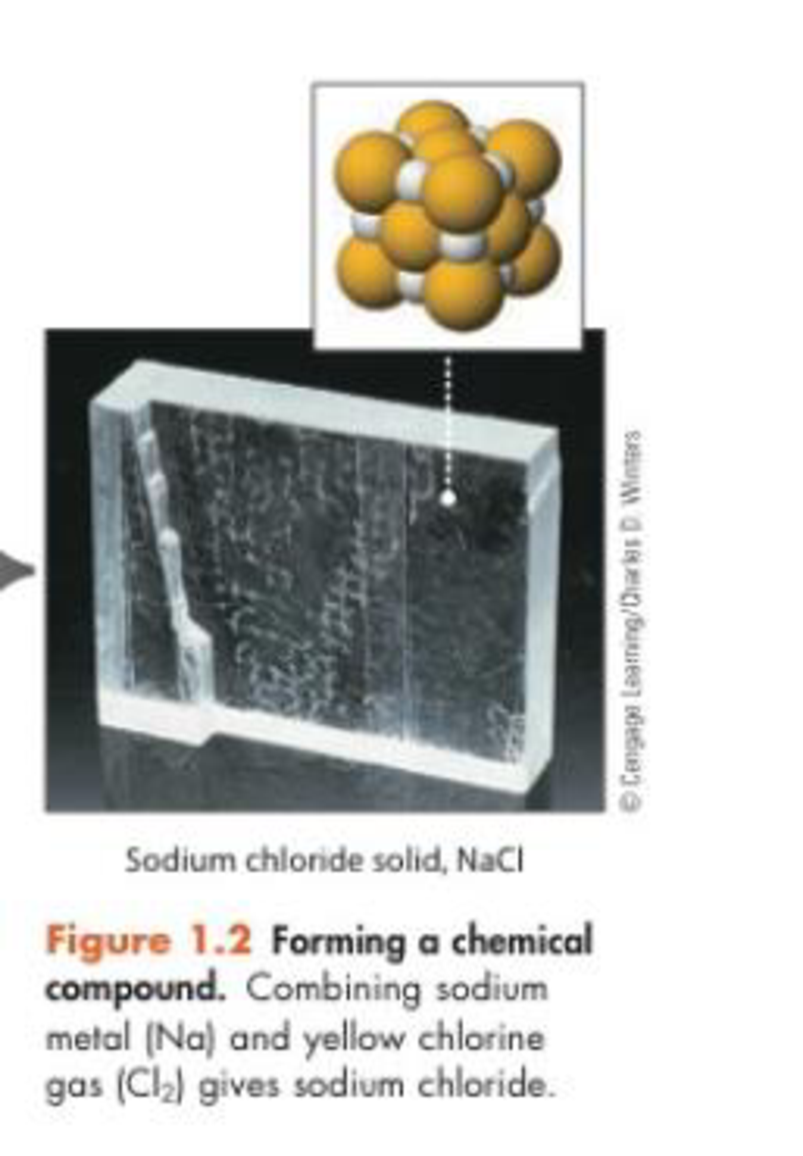
Chemistry & Chemical Reactivity
9th Edition
ISBN: 9781305176461
Author: Kotz
Publisher: Cengage
expand_more
expand_more
format_list_bulleted
Concept explainers
Textbook Question
Chapter 1, Problem 25GQ
In Figure 1.2 you see a piece of salt and a representation of its internal structure. Which is the macroscopic view and which is the particulate view? How are the macroscopic and particulate views related?

Expert Solution & Answer
Want to see the full answer?
Check out a sample textbook solution
Students have asked these similar questions
7. Consider the following reaction that describes the dissolution of copper metal in nitric acid:
Cu (s)
+ 4 HNO3 (aq)
→
Cu(NO3)2 (aq) +
2 H₂O (1)
+
2 NO2 (g)
How many mL of 3.50 M HNO3 (aq) are required to dissolve 20.00 g Cu?
Please correct answer and don't used hand raiting
Don't used Ai solution
Chapter 1 Solutions
Chemistry & Chemical Reactivity
Ch. 1.3 - Which of the following is a pure substance? (a)...Ch. 1.3 - Which of the following is not characteristic of a...Ch. 1.4 - Prob. 1RCCh. 1.4 - Prob. 2RCCh. 1.5 - Prob. 1RCCh. 1.5 - 2. Which of the following is NOT a...Ch. 1.6 - Which of the following is NOT a physical property?...Ch. 1.6 - 2. A piece of a polypropylene rope (used for water...Ch. 1.6 - Which of the following is an extensive property of...Ch. 1.7 - When camping in the mountains, you boil a pot of...
Ch. 1.8 - Much has been written about CO2.What is its name?Ch. 1.8 - Prob. 2QCh. 1.8 - Prob. 3QCh. 1.8 - The spines of the sea urchin, corals, and...Ch. 1.8 - Which of the following has the highest thermal...Ch. 1.8 - Prob. 2RCCh. 1 - Give the name of each of the following elements:...Ch. 1 - Give the name of each of the following elements:...Ch. 1 - Give the symbol for each of the following...Ch. 1 - Give the symbol for each of the following...Ch. 1 - In each of the following pairs, decide which is an...Ch. 1 - In each of the following pairs, decide which is an...Ch. 1 - In each case, decide if the underlined property is...Ch. 1 - In each case, decide if the change is a chemical...Ch. 1 - Which part of the description of a compound or...Ch. 1 - Which part of the description of a compound or...Ch. 1 - The flashlight in the photo does not use...Ch. 1 - A solar panel is pictured in the photo. When light...Ch. 1 - Determine which of the following represent...Ch. 1 - Prob. 14PSCh. 1 - Prob. 15GQCh. 1 - Iron pyrite (fool's gold, page 11) has a shiny...Ch. 1 - Which observations below describe chemical...Ch. 1 - Which observations below describe chemical...Ch. 1 - The mineral fluorite contains the elements calcium...Ch. 1 - Azurite, a blue, crystalline mineral, is composed...Ch. 1 - You have a solution of NaCI dissolved in water....Ch. 1 - Small chips of iron are mixed with sand (see...Ch. 1 - Identify the following as either physical changes...Ch. 1 - Identify the following as either physical changes...Ch. 1 - In Figure 1.2 you see a piece of salt and a...Ch. 1 - In Figure 1.5 you see macroscopic and particulate...Ch. 1 - Prob. 27GQCh. 1 - The following photo shows copper balls, immersed...Ch. 1 - Categorize each of the following as an element, a...Ch. 1 - Categorize each of the following as an element, a...Ch. 1 - Make a drawing, based on the kinetic-molecular...Ch. 1 - Make a drawing, based on the kinetic-molecular...Ch. 1 - Hexane (C6H14, density = 0.766 g/cm3),...Ch. 1 - You have a sample of a white crystalline substance...Ch. 1 - You can figure out whether a solid floats or sinks...Ch. 1 - You are given a sample of a silvery metal. What...Ch. 1 - Milk in a glass bottle was placed in the freezing...Ch. 1 - Describe an experimental method that can be used...Ch. 1 - Diabetes can alter the density of urine, so urine...Ch. 1 - Prob. 40GQCh. 1 - The following photo shows the element potassium...Ch. 1 - Prob. 42GQCh. 1 - Four balloons are each filled with a different...Ch. 1 - Prob. 44GQCh. 1 - The photo below shows elemental iodine dissolving...Ch. 1 - A few years ago a young chemist in Vienna,...
Additional Science Textbook Solutions
Find more solutions based on key concepts
The validity of a scientific law.
Physical Universe
Give the IUPAC name for each compound.
Organic Chemistry
What process causes the Mediterranean intermediate Water MIW to become more dense than water in the adjacent At...
Applications and Investigations in Earth Science (9th Edition)
Why are mutants used as test organisms in the Ames test?
Laboratory Experiments in Microbiology (12th Edition) (What's New in Microbiology)
Why do scientists think that all forms of life on earth have a common origin?
Genetics: From Genes to Genomes
Define histology.
Fundamentals of Anatomy & Physiology (11th Edition)
Knowledge Booster
Learn more about
Need a deep-dive on the concept behind this application? Look no further. Learn more about this topic, chemistry and related others by exploring similar questions and additional content below.Similar questions
- 3. An unknown element, X, combines with chlorine to give a substance with the formula XC14. A chlorine analysis of the substance indicates that it contains 83.47% chlorine by mass. What element is X and what is the formula of this compound? (Hint: to identify an element or compound, identify its molar mass. Remember that Molar Mass = (grams A)/(moles A). Solve for each individually and then divide them to find molar mass.)arrow_forward1. When hydrogen sulfide (H2S, MM = 34.08 g/mol) gas is bubbled into a solution of sodium hydroxide (NaOH, 40.00 g/mol), sodium sulfide (Na2S, 78.04 g/mol) and water (18.02 g/mol) are produced according to the balanced chemical equation shown below? H2S 2 NaOH --> Na2S 2 H₂O (a) Assuming the reaction goes to completion, how many grams of sodium sulfide are formed if 2.50g of hydrogen sulfide is bubbled into a solution containing 1.85g of NaOH? (20 pts) (b) Which reactant and how much of it remains after the reaction has been completed? (15 pts) (c) If only 0.400g of sodium sulfide was recovered, what is the percent yield of this reaction (5 pts)arrow_forwardThe organic compound MTBE (methyltertiarybutylether) is used as a fuel additive that allows gasoline to burn more cleanly thus leading to a reduction in pollution. Recently, however, MTBE has been found in the drinking water of a number of communities. As a result several states are phasing out the use of MTBE as a fuel additive. A combustion experiment using 10.00 g of MTBE was found to produce 24.97g of CO2 and 12.26 g of H2O. (a) What is the empirical formula of MTBE assuming it contains C, H, and O only? (b) The molar mass of MTBE was experimentally determined to be 88.1 g/mol. Using this information what is the molecular formula of MTBEarrow_forward
- Part 4: Provide a detailed retrosynthetic analysis and a plausible forward synthesis the following molecule. храдо ofarrow_forward3A: Starting with benzocyclobutene, synthesize the naphthalene derivative below.arrow_forward7. The addition of HBr to 2,5-dimethyl-2,4-heptadiene gives the same product, A, at both low and high temperatures. Provide the structure of A and explain the kinetic and thermodynamic product are the same in this reaction. HBr -78°C or 60°C Aarrow_forward
- 3B: Convert the starting material into the chiral epoxytriol below. OH OH = OH OHarrow_forward3D: Convert the aromatic triketone to the 1,3,5-triethylcyclohexane shown below. ہوئےarrow_forwardIndicate how to find the energy difference between two levels in cm-1, knowing that its value is 2.5x10-25 joules.arrow_forward
- The gyromagnetic ratio (gamma) for 1H is 2.675x108 s-1 T-1. If the applied field is 1,409 T what will be the separation between nuclear energy levels?arrow_forwardChances Ad ~stract one 11. (10pts total) Consider the radical chlorination of 1,3-diethylcyclohexane depicted below. 4 • 6H total $4th total Statistical pro 21 total 2 H A 2H 래 • 4H totul < 3°C-H werkest bund - abstraction he leads to then mo fac a) (6pts) How many unique mono-chlorinated products can be formed and what are the structures for the thermodynamically and statistically favored products? рос 6 -વા J Number of Unique Mono-Chlorinated Products Thermodynamically Favored Product Statistically Favored Product b) (4pts) Draw the arrow pushing mechanism for the FIRST propagation step (p-1) for the formation of the thermodynamically favored product. Only draw the p-1 step. You do not need to include lone pairs of electrons. No enthalpy calculation necessary H H-Clarrow_forwardWhat is the lone pair or charge that surrounds the nitrogen here to give it that negative charge?arrow_forward
arrow_back_ios
SEE MORE QUESTIONS
arrow_forward_ios
Recommended textbooks for you
 Chemistry & Chemical ReactivityChemistryISBN:9781337399074Author:John C. Kotz, Paul M. Treichel, John Townsend, David TreichelPublisher:Cengage Learning
Chemistry & Chemical ReactivityChemistryISBN:9781337399074Author:John C. Kotz, Paul M. Treichel, John Townsend, David TreichelPublisher:Cengage Learning Chemistry & Chemical ReactivityChemistryISBN:9781133949640Author:John C. Kotz, Paul M. Treichel, John Townsend, David TreichelPublisher:Cengage Learning
Chemistry & Chemical ReactivityChemistryISBN:9781133949640Author:John C. Kotz, Paul M. Treichel, John Townsend, David TreichelPublisher:Cengage Learning World of Chemistry, 3rd editionChemistryISBN:9781133109655Author:Steven S. Zumdahl, Susan L. Zumdahl, Donald J. DeCostePublisher:Brooks / Cole / Cengage Learning
World of Chemistry, 3rd editionChemistryISBN:9781133109655Author:Steven S. Zumdahl, Susan L. Zumdahl, Donald J. DeCostePublisher:Brooks / Cole / Cengage Learning Chemistry: The Molecular ScienceChemistryISBN:9781285199047Author:John W. Moore, Conrad L. StanitskiPublisher:Cengage Learning
Chemistry: The Molecular ScienceChemistryISBN:9781285199047Author:John W. Moore, Conrad L. StanitskiPublisher:Cengage Learning Chemistry for Engineering StudentsChemistryISBN:9781337398909Author:Lawrence S. Brown, Tom HolmePublisher:Cengage Learning
Chemistry for Engineering StudentsChemistryISBN:9781337398909Author:Lawrence S. Brown, Tom HolmePublisher:Cengage Learning Introductory Chemistry: A FoundationChemistryISBN:9781337399425Author:Steven S. Zumdahl, Donald J. DeCostePublisher:Cengage Learning
Introductory Chemistry: A FoundationChemistryISBN:9781337399425Author:Steven S. Zumdahl, Donald J. DeCostePublisher:Cengage Learning

Chemistry & Chemical Reactivity
Chemistry
ISBN:9781337399074
Author:John C. Kotz, Paul M. Treichel, John Townsend, David Treichel
Publisher:Cengage Learning

Chemistry & Chemical Reactivity
Chemistry
ISBN:9781133949640
Author:John C. Kotz, Paul M. Treichel, John Townsend, David Treichel
Publisher:Cengage Learning

World of Chemistry, 3rd edition
Chemistry
ISBN:9781133109655
Author:Steven S. Zumdahl, Susan L. Zumdahl, Donald J. DeCoste
Publisher:Brooks / Cole / Cengage Learning

Chemistry: The Molecular Science
Chemistry
ISBN:9781285199047
Author:John W. Moore, Conrad L. Stanitski
Publisher:Cengage Learning

Chemistry for Engineering Students
Chemistry
ISBN:9781337398909
Author:Lawrence S. Brown, Tom Holme
Publisher:Cengage Learning

Introductory Chemistry: A Foundation
Chemistry
ISBN:9781337399425
Author:Steven S. Zumdahl, Donald J. DeCoste
Publisher:Cengage Learning
Types of Matter: Elements, Compounds and Mixtures; Author: Professor Dave Explains;https://www.youtube.com/watch?v=dggHWvFJ8Xs;License: Standard YouTube License, CC-BY